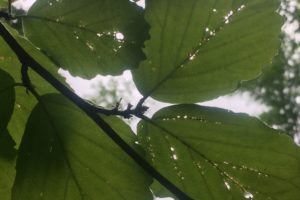I’ve just finished Joan Maloof’s wonderful book Nature’s Temples, The Complex World of Old-Growth Forests. I’d also like to add that the book was beautifully illustrated by friend and fellow arborist Andrew Joslin (a.k.a Moss).
Many things were covered including forest management, biodiversity, climate history and the effects on wildlife, birds, snails worms and fungi. There were graphs on temperature change and tables of carbon sequestering. I felt like I was tucked into the thick organic layer of the forest floor as I read vigorously before bed each night. Not only do I have a better appreciation for ancient forests and how they operate as systems, but for trees in general, and how they support life, and how they come to embody a concept of beauty.
For arborists in particular, I think the last chapter of the text holds the most weight. It’s entitled Do humans need the forest? In this section Maloof explains a test that she developed in order to quantify scientifically the level of beauty people perceived when they went into a forest. Her theory was that older, more complex forests were more beautiful. The test was quite simple, “present subjects with a pencil and sheet of paper with a horizontal line on it; “less beautiful” is written at the extreme left end of the line and “more beautiful” at the extreme right end. Then lead them into forest of various ages and have them put a mark on the line anywhere they like…I did not tell my subjects the age of the forests or anything else about them. After they put marks on their papers, I measured the positive or negative distance from each mark to the neutral point at the center of the line, and those numbers became the subjects’ scores for each forest. These numbers went into an Excel spreadsheet and were statistically analyzed. The result of that analysis showed, scientifically, that older forests are indeed experienced as being more beautiful” (page 170).
This concept of beauty and how it is perceived by people is quite fascinating to me, on several levels. For one, I am interested in the relationship of how people perceive beauty, and if there is a disconnect then in the way they implement management on those entities of beauty (ie. trees, forests). For example: Maloof’s test shows that people obviously believe older forests are more beautiful, but yet, as humans, we have depleted those forests exponentially. What is the economic value of that beauty then? Another is that as arborists, there is a level of art to our trade (arboriculture as art and science). Therefore the perception of beauty has definite financial returns. Or does it? People essentially pay us to keep their trees beautiful…right?
Imagine presenting people with Maloof’s test, except instead of showing them forests, you showed different types of trees: large, ancient spreading elms, and topped Norway Maples or Pears riddled with girdling roots trapped on a tree lawn. I’m certain people would be identifying the old, ancient sprawling trees with fascinating architecture as the most beautiful specimen. But that won’t stop people from mistreating their trees. I mean, “prune as much off as you can without killing it.”
If I come away with anything after I read Nature’s Temples, it’s that I feel there is a disconnect between people’s perception of beauty and how we implement that perception into practice. It’s a bit saddening. We like the ideal, but it seems that it only stays an idea for the most part. Maloof herself has established the Old-Growth Forest Network. It is a network of forests that will never be logged and available to the public. Joan Maloof has demonstrated what it is to put beauty into practice. It’s the preservation and protection of not only beauty, but what she believes in.
Arborists can take this concept of preservation and put it into practice as well. The idea of less intervention by way of intervention. I believe we need to help trees grow old and complex in the same way we help forests grow old and complex, by guarding them, by studying them, by speaking for them, and most importantly, by experiencing them. If forests are the temples of nature, then trees are the high altar upon which we worship nature’s beauty.
There is no doubt we need them.





Leave a Reply
Your email is safe with us.